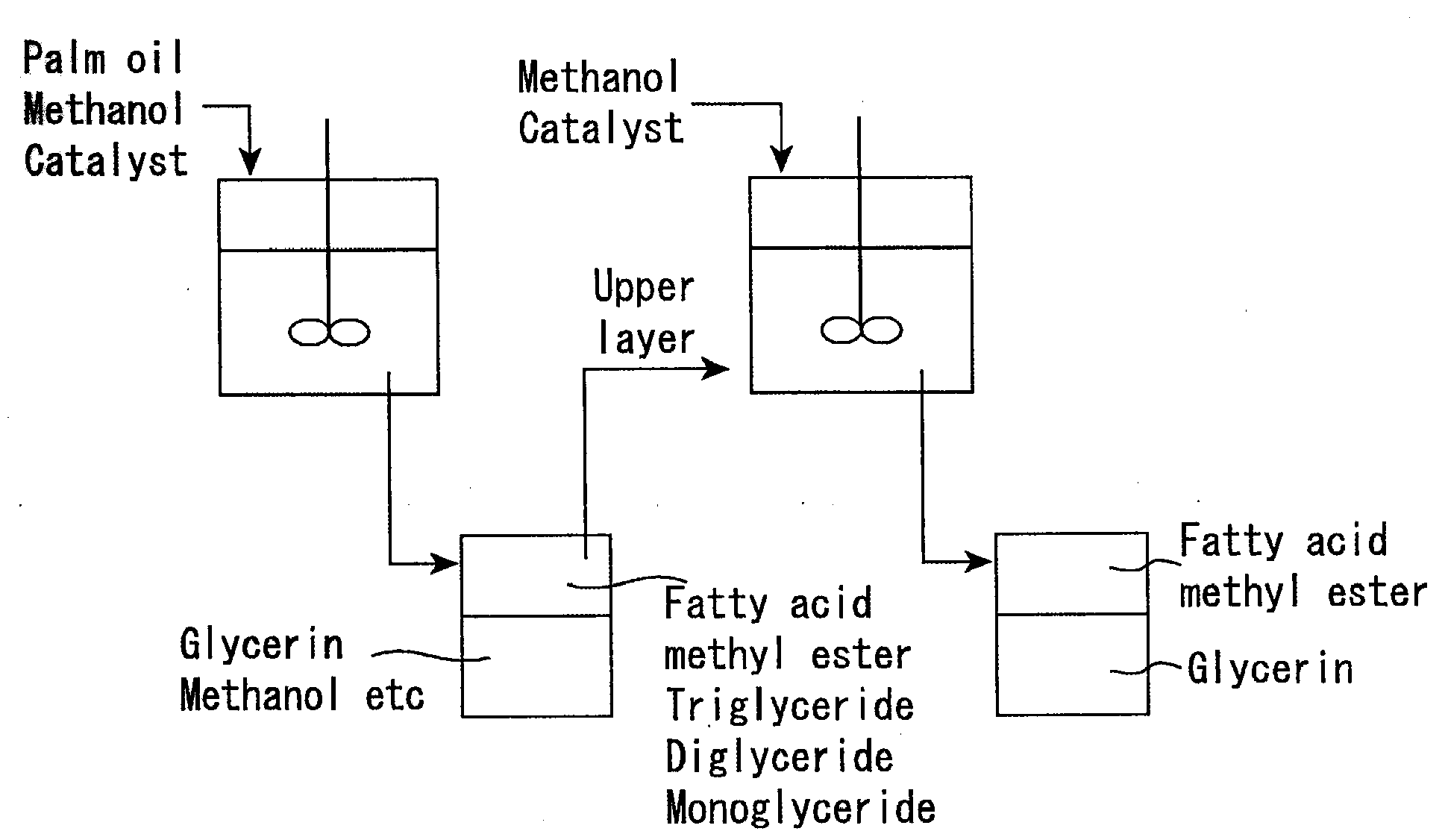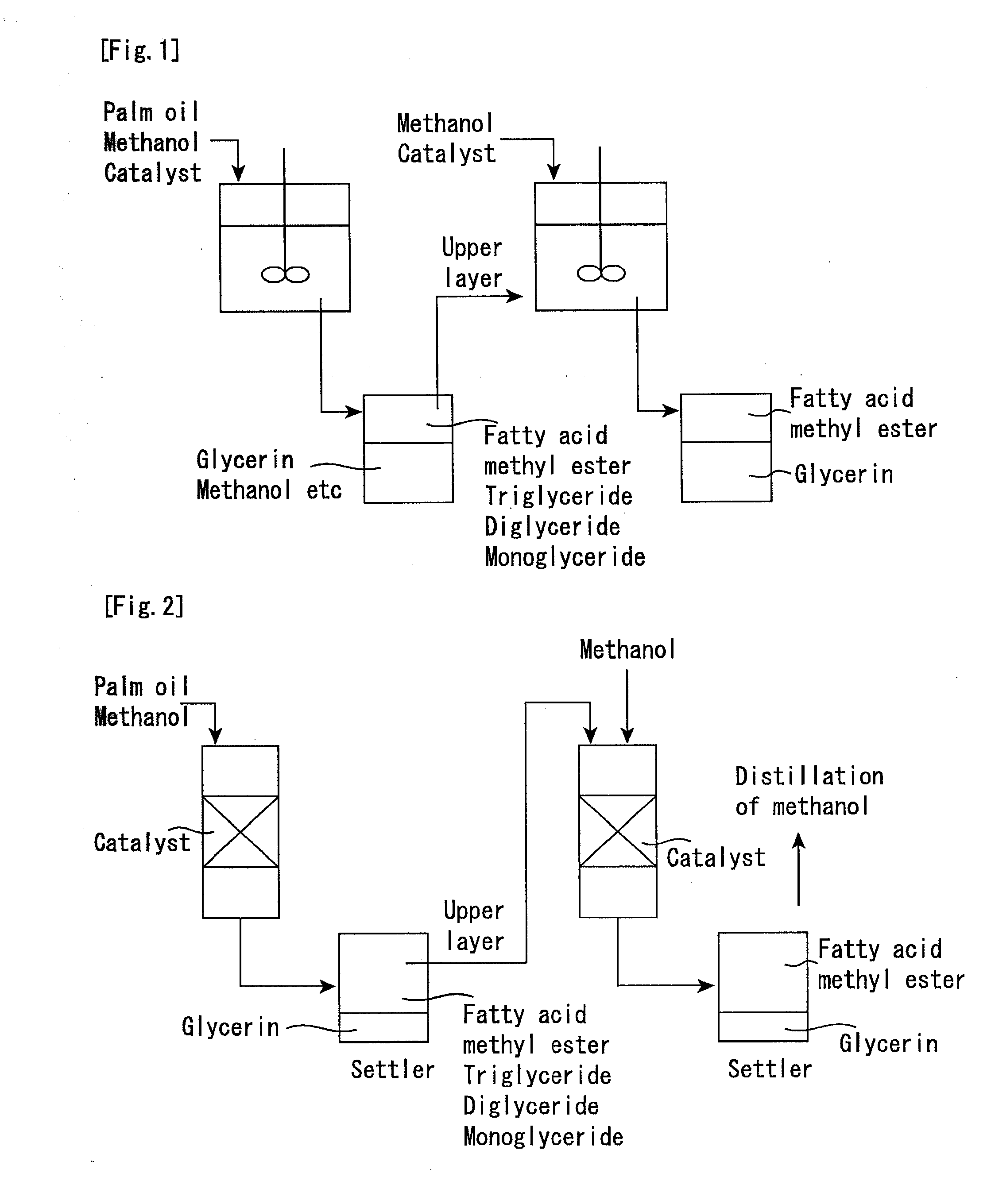[0071]The catalyst preferably contains a
sulfur component of 700 ppm or less. If the catalyst contains a
sulfur component of 700 ppm or more, the catalyst activity and the catalyst life might be insufficiently improved. Therefore, functional effects of the invention, in which the catalyst separation, removal, and
recovery steps can be remarkably simplified or omitted and the catalyst can be repeatedly used for continuous reactions, might not be exhibited. The content of sulfur components is preferably 500 ppm or less, and more preferably 200 ppm or less. The content of sulfur components in the catalyst can be determined by
fluorescence X rays (XRF) analysis or
high frequency induction
plasma (ICP) emission spectrometry. According to XRF analysis, the component can be determined by measuring a catalyst
powder as it is or by a glass bead method. According to ICP emission spectrometry, the component can be determined by measuring a catalyst
powder after being dissolved in a
hydrofluoric acid aqueous solution. However, the sulfur component is preferably determined by a glass bead method of XRF, in view of ease of measurement.
[0072]For reducing the sulfur component contained in the catalyst, for example, the catalyst may be prepared using no
sulfate as a
raw material, or using sufficiently reduced amount of
sulfate, or washed with sufficient amount of a
solvent such as water.
[0073]A calcined metal oxide may be used as the above-mentioned catalysts (catalysts (I) to (V)), which can further suppress leaching of the active metal component. The
calcination temperature is preferably determined in consideration of the catalyst surface area and the
crystal structure, and preferably has a
lower limit of 280° C. and an upper limit of 1300° C., for example. If the temperature is less than 280° C., suppression of the leaching may be insufficient, for example the catalyst contains more amorphous
titanium oxide. If it is more than 1300° C., sufficient catalyst surface area might not be obtained sufficiently, which fails to produce fatty acid alkyl esters and / or glycerin with high efficiency. More preferably, the
lower limit is 400° C., and the upper limit is 1200° C. The
calcination time preferably has a
lower limit of 30 minutes and an upper limit of 24 hours. More preferably, the lower limit is 1 hour, and the upper limit is 12 hours.
Gas phase atmosphere during the
calcination is preferably air,
nitrogen,
argon,
oxygen, and
hydrogen atmosphere, and also
mixed gas thereof. And more preferably, the calcination is carried out under air or
nitrogen atmosphere. Particularly if a metal species constituting the
ilmenite structure in the metal oxide is oxidized by
oxygen in air when calcined in
air atmosphere, the metal oxide is preferably calcined in
inert gas atmosphere, such as in
nitrogen atmosphere in view of stability of the
ilmenite crystal structure. If the catalyst, in which the
active component consisted of a single or
mixed oxide of the metallic element is carried or immobilized on the carrier, is produced, as mentioned above, the catalyst is preferably produced by mixing and carrying the
active component on a compound used as a carrier by an impregnation method or a kneading method and the like, and then by calcinating the compound under the above-mentioned calcination conditions. Thus-produced catalyst can disperse the
active component sufficiently over the carrier surface to function as a
solid catalyst.
[0074]Furthermore, the above-mentioned catalyst preferably has insolubility to any of a fat or oil, an
alcohol, and a product (fatty acid alkyl esters, glycerin and the like) under
reaction conditions (hereinafter referred also to as “insoluble catalyst”). In the reaction of bringing a fat or oil into contact with an
alcohol in the presence of the catalyst, the reaction mixture will separates into two phases as the reaction proceeds: one (ester phase) mainly containing a fatty acid alkyl ester; and the other (glycerin phase) mainly containing glycerin, which is a byproduct. In this case, both phases contain the alcohol, and as a result, the fatty acid alkyl ester and the glycerin distribution into two phases. If the alcohol is removed by
evaporation in the absence of the catalyst,
mutual solubility of the upper layer mainly containing the fatty acid alkyl ester and the lower layer mainly containing the glycerin decreases, which accelerates the separation of the fatty acid alkyl ester from the glycerin. Therefore,
recovery ratio can be improved. If the active metal component leaches out from the catalyst, a reverse reaction proceeds in the above-mentioned step and thereby yield of the fatty acid alkyl ester decreases because
transesterification is a
reversible reaction. As mentioned above, the phase separation after removing the alcohol from the reaction mixture by
evaporation in the absence of the catalyst brings about easy purification and high isolated yield during the production method of fatty acid alkyl esters and / or glycerin. That is, preferable embodiment of the present invention includes the production method comprises a step of bringing a fat or oil and an alcohol in the presence of the catalyst, wherein the catalyst is insoluble to any of the fat or oil, the alcohol, and the product (fatty acid alkyl esters, glycerin and the like), and the alcohol is removed by
evaporation in the absence of the catalyst before the ester phase and the glycerin phase, which are reaction mixture, are separated. Furthermore, addition of water in minute amounts further improves the separation of the fatty acid alkyl ester from the glycerin and the purification thereof.
[0075]The term “the absence of the catalyst” so referred to above means that the
reaction product solution hardly contains an insoluble
solid catalyst and has a total concentration of active metal components leached from the insoluble
solid catalyst of 1000 ppm or less. The term “active metal component leached” means metal components derived from the insoluble solid catalyst eluted into the reaction solution and capable of serving as a homogeneous catalyst with catalytic activity in a
transesterification and / or esterification under operation conditions. The leached active metal component having a concentration of more than 1000 ppm fails to suppress the reverse reaction sufficiently in the above-mentioned alcohol-distilled step. Therefore, load of utility in the production can be insufficiently reduced. The concentration is preferably 800 ppm or less, and more preferably 600 ppm or less, and still more preferably 300 ppm or less. Most preferably, the
reaction product solution substantially contains no active metal component.
[0076]The leaching amount of the above-mentioned active metal components of the catalyst in the reaction solution can be determined by subjecting the reaction solution as it is to fluorescent X-
ray spectroscopy (XRF) analysis. Smaller leaching amount is preferably determined by
inductively coupled plasma (ICP) emission spectrometry.
 Login to View More
Login to View More 


